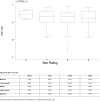Cross sectional study of performance indicators for English Primary Care Trusts: testing construct validity and identifying explanatory variables
- PMID: 16805907
- PMCID: PMC1526428
- DOI: 10.1186/1472-6963-6-81
Cross sectional study of performance indicators for English Primary Care Trusts: testing construct validity and identifying explanatory variables
Abstract
Background: The performance of Primary Care Trusts in England is assessed and published using a number of different performance indicators. Our study has two broad purposes. Firstly, to find out whether pairs of indicators that purport to measure similar aspects of quality are correlated (as would be expected if they are both valid measures of the same construct). Secondly, we wanted to find out whether broad (global) indicators correlated with any particular features of Primary Care Trusts, such as expenditure per capita.
Methods: Cross sectional quantitative analysis using data from six 2004/05 PCT performance indicators for 303 English Primary Care Trusts from four sources in the public domain: Star Rating, aggregated Quality and Outcomes Framework scores, Dr Foster mortality index, Dr Foster equity index (heart by-pass and hip replacements), NHS Litigation Authority Risk Management standards and Patient Satisfaction scores from the Star Ratings. Forward stepwise multiple regression analysis to determine the effect of Primary Care Trust characteristics on performance.
Results: Star Rating and Quality and Outcomes Framework total, both summary measures of global quality, were not correlated with each other (F = 0.66, p = 0.57). There were however positive correlations between Quality and Outcomes Framework total and patient satisfaction (r = 0.61, p < 0.001) and between screening/'additional services' indicators on the Star Ratings and Quality and Outcomes Framework (F = 24, p < 0.001). There was no correlation between different measures of access to services. Likewise we found no relationship between either Star Rating or Litigation Authority Standards and hospital mortality (F = 0.61, p = 0.61; F = 0.31, p = 0.73).
Conclusion: Performance assessment in healthcare remains on the Government's agenda, with new core and developmental standards set to replace the Star Ratings in 2006. Yet the results of this analysis provide little evidence that the current indicators have sufficient construct validity to measure the underlying concept of quality, except when the specific area of screening is considered.
Figures
Similar articles
-
Do the UK government's new Quality and Outcomes Framework (QOF) scores adequately measure primary care performance? A cross-sectional survey of routine healthcare data.BMC Health Serv Res. 2007 Oct 17;7:166. doi: 10.1186/1472-6963-7-166. BMC Health Serv Res. 2007. PMID: 17941984 Free PMC article.
-
Do performance indicators predict regulator ratings of healthcare providers? Cross-sectional study of acute hospitals in England.Int J Qual Health Care. 2020 Apr 27;32(2):113-119. doi: 10.1093/intqhc/mzz101. Int J Qual Health Care. 2020. PMID: 31725874 Free PMC article.
-
Factors relating to patients' reports about hospital care for coronary heart disease in England.J Health Serv Res Policy. 2003 Apr;8(2):83-6. doi: 10.1258/135581903321466049. J Health Serv Res Policy. 2003. PMID: 12820669
-
Rapid evaluation of the Special Measures for Quality and challenged provider regimes: a mixed-methods study.Health Soc Care Deliv Res. 2023 Oct;11(19):1-139. doi: 10.3310/GQQV3512. Health Soc Care Deliv Res. 2023. PMID: 37921786 Review.
-
Development of a core set of quality indicators for paediatric primary care practices in Europe, COSI-PPC-EU.Eur J Pediatr. 2018 Jun;177(6):921-933. doi: 10.1007/s00431-018-3140-z. Epub 2018 Apr 14. Eur J Pediatr. 2018. PMID: 29654400
Cited by
-
Do the UK government's new Quality and Outcomes Framework (QOF) scores adequately measure primary care performance? A cross-sectional survey of routine healthcare data.BMC Health Serv Res. 2007 Oct 17;7:166. doi: 10.1186/1472-6963-7-166. BMC Health Serv Res. 2007. PMID: 17941984 Free PMC article.
-
Hitting and missing targets by ambulance services for emergency calls: effects of different systems of performance measurement within the UK.J R Stat Soc Ser A Stat Soc. 2009 Jan;172(1):161-190. doi: 10.1111/j.1467-985X.2008.00557.x. J R Stat Soc Ser A Stat Soc. 2009. PMID: 19381327 Free PMC article.
-
Association between primary care organisation population size and quality of commissioning in England: an observational study.Br J Gen Pract. 2012 Jan;62(594):e46-54. doi: 10.3399/bjgp12X616364. Br J Gen Pract. 2012. PMID: 22520680 Free PMC article.
-
Creation of a synthetic indicator of quality of care as a clinical management standard in primary care.Springerplus. 2013 Dec;2(1):51. doi: 10.1186/2193-1801-2-51. Epub 2013 Feb 13. Springerplus. 2013. PMID: 23450738 Free PMC article.
-
Developing performance indicators for primary care: Walsall's experience.Br J Gen Pract. 2008 Dec;58(557):856-61. doi: 10.3399/bjgp08X376096. Br J Gen Pract. 2008. PMID: 19068159 Free PMC article.
References
-
- Department of Health. Performance Ratings. 2002. http://www.performance.doh.gov.uk/performanceratings/2002/national.html
-
- Marshall M, Noble J, Davies H, Walshe K, Waterman H, Sheaff R, Elwyn G. Producing information about general practice services that makes sense to patients and the public. Manchester: National Primary Care Research and Development Centre. 2005.
Publication types
MeSH terms
LinkOut - more resources
Full Text Sources
Molecular Biology Databases





